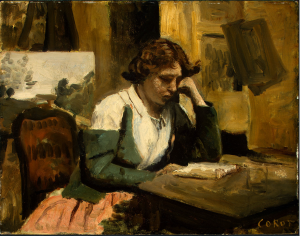
Rather than focus on one artwork, I thought I would just share with you some of the gentle landscapes for which Camille Corot is so well admired. These realist (nature) works had a strong influence on the Impressionists who were to follow.
Camille Corot grew up in a middle-class family in Rouen, France, where he was a draper’s apprentice. From the age of 26 he pursued a career as an artist, taking painting lessons from A.E. Michallon and Victor Bertin, who ran a school for landscape painting.
In the autumn of 1825 Corot travelled to Rome to study the masters of the Italian Renaissance, but spent most of his time around Rome and in the Italian countryside. He considered that the three years that he spent in Italy were the most influential of his life, and he returned in 1834 and 1843.
Back in France, Corot constantly travelled in the warmer months, sketching and making preparatory studies, before returning to his studio to paint in winter.
He approached his landscapes in a traditional manner. His palette was restrained and dominated by browns and blacks, together with dark and silvery green. Although at times his brushstrokes appeared to be rapid and spontaneous, they were usually controlled and careful. His compositions were well planned and generally rendered as simply and concisely as possible, heightening the poetic effect of the imagery. As he stated, “I noticed that everything that was done correctly on the first attempt was more true, and the forms more beautiful.” With an instinctive sense of arrangement, and drawing on the lessons of his former teachers, Corot gave his works a seemingly natural harmony and balance, responding to the light and atmosphere of the views he painted.
From 1831 he held regular and successful exhibitions in Paris. He understood that to be noticed on the crowded walls of the Salon he needed to work on an impressive scale and include interesting subject matter into his foregrounds. Using his sketches and studies from Italy and around Barbizon near the Fontainebleau Forest he composed landscapes of increasingly large size, enlivening their foregrounds with rustic genre motifs. His first success came at the Salon of 1833, where his Vue de la forêt de Fontainebleau won a silver medal.
From the 1850s Corot’s style drew greater admiration from his fellow artists. His work from this time on fell into three main categories: private studies from nature of landscape or of the human figure; more academic historical compositions destined for the Salon; and composed landscapes in hazily atmospheric settings destined for sale – for which there developed a strong demand. He called these landscape souvenirs and paysages, dreamy imagined paintings of remembered locations from earlier visits painted with lightly and loosely dabbed strokes. It is these works in particular which have endured as a legacy.





